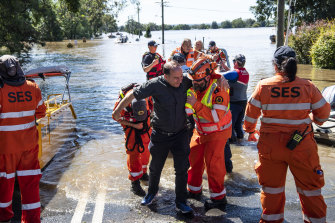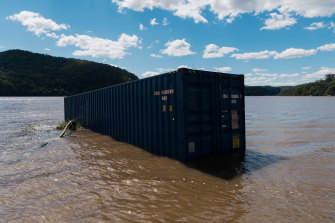SES braces for busy storm season complicated by COVID-19 restrictions
The NSW State Emergency Service is preparing for a heightened risk of floods during the coming storm season with about a third of its metropolitan staff residents in COVID-19 hotspots.
The odds for a hectic season of rescues increased on Tuesday, with the Bureau of Meteorology lifting its assessment of a La Nina event in the Pacific to a 50-50 chance. Those crews might not have to wait long for action, with widespread rains expected to move across much of the state this week, triggering flood alerts in some areas.

State Emergency Services assisting people affected by large floods near Sydney in March.Credit:Louise Kennerley
Warm Indian Ocean waters off north-western Australia are already creating conditions that favour cloud and rain patterns likely to create a damper than usual spring in south-eastern parts of the country. A switch to a “La Nina watch†means those wetter than normal conditions will extend into the summer.
“We’re expecting a busy season ahead of us in terms of widespread rainfall and flooding,†Francois Geffroy, a bureau meteorologist assigned to the SES, said. “And then on top of that, there’s the chance of increased tropical cyclone activity if that La Nina comes.â€
The SES has already had to provide flood assistance during the COVID-19 pandemic, including during last March’s broadscale deluges that triggered more than 14,000 calls for aid and 1000-plus rescues.
This time, government-imposed restrictions could complicate procedures. The SES counts 10,200 volunteers statewide with 4500 in metropolitan Sydney of which about 1600 are in the city’s 12 local government areas declared to be COVID-19 hotspots.
Restrictions add to the challenges of moving staff around, as well as how to evacuate people in harm’s way.
“Instead of putting them into big evacuation centres, it’s really important they have a plan of where they can go to that’s safe,†Carlene York, the SES Commissioner, said. “Right now, we’re saying that’s family and friends where possible.
“We’re allowed to move our volunteers from those [12] LGAs when there’s an emergency. But we’ll try to avoid moving [any of them], and bringing volunteers from regional areas as a first line of support.â€

A shipping container washed up in the Hawkesbury River near Sydney during the March floods.Credit:James Brickwood
Volunteers, meanwhile, have been encouraged to get vaccinated, with a couple of centres set up for emergency workers.
“We’ve had hardly any scares within our units,†Ms York said. “We’ve only had to do a couple of deep cleans at a couple of units ... We’ve been lucky.â€
The SES will also conduct risk assessments to determine which, if any, roles will require staff to be vaccinated, Ms York said. The agency is working with the Rural Fire Service, which has a similar dependence on volunteers, to coordinate COVID-19 procedures.
In the next few weeks, the focus is likely to be in areas such as west of the Blue Mountains, where the Lachlan River has recently been flooding. The Riverina and the Snowy regions are also being watched.
“We are operational in those areas at the moment,†Ms York said, adding “the saturation of the ground and the fullness of the dams†means flood risks will be elevated with even modest rainfall tallies.
By contrast, dam levels were much lower ahead of heavy rains last March. “We’ve already started reaching out to other emergency service agencies, local councils just for planning and preparation,†Ms York said.
While tropical cyclones don’t reach as far south as NSW, remnants from the tempests can create heavy rain over parts of the state. Deluges in southern Queensland can also fill inland rivers that flow into the state.
“From preparing an emergency evacuation kit, making sure your gutters and down pipers are clear, to planning for your animals, you can find all this information and more via ses.nsw.gov.au,†Ms York said.